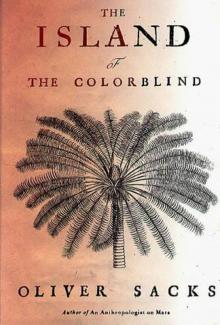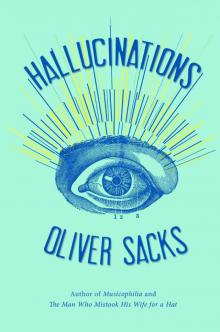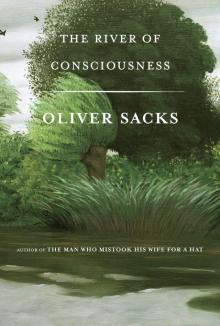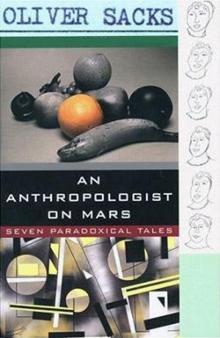- Home
- Oliver Sacks
Oaxaca Journal Page 2
Oaxaca Journal Read online
Page 2
Ferns delighted me with their curlicues, their croziers, their Victorian quality (not unlike the frilled antimacassars and lacy curtains in our house). But at a deeper level, they filled me with wonder because they were of such ancient origin. All of the coal that heated our home, my mother told me, was essentially composed of ferns or other primitive plants, greatly compressed, and one could sometimes find their fossils by splitting coal balls. Ferns had survived, with little change, for a third of a billion years. Other creatures, like dinosaurs, had come and gone, but ferns, seemingly so frail and vulnerable, had survived all the vicissitudes, all the extinctions the earth had known. My sense of a prehistoric world, of immense spans of time, was first stimulated by ferns and fossil ferns.
“What gate do we go from?” everyone is asking. “It’s Gate 10,” someone says. “They told me it was Gate 10.”
“No, it’s Gate 3,” someone else says, “It’s up there on the board, Gate 3.” Yet another person has been told we are leaving from Gate 5. I have an odd feeling that the gate number is still, at this point, indeterminate. One thought is that there are only rumors of gate numbers until, at a critical point, one number wins. Or that the gate is indeterminable in a Heisenbergian sense, only becoming determinate at the final moment (which, if I have the right phrase, “collapses the wave function”). Or that the plane, or its probability, leaves from several gates simultaneously, pursuing all possible paths to Oaxaca.
Slight tension, hanging around, the gate finally resolved, awaiting the boarding call. Our plane was supposed to leave at 4:45 p.m., and now it is 4:50 and we have not even been boarded. (The plane, though, is here, waiting outside.) More meetings, encounters. There are nine of us now, or rather, eight of them—and me. For I have now retracted a little from the group, and am sitting a few yards from them, scribbling in my notebook.
There is almost always this doubleness, that of the participant-observer, as if I were a sort of anthropologist of life, of terrestrial life, of the species Homo sapiens. (This, I suppose, is why I took Temple Grandin’s words as the title of An Anthropologist on Mars, for I, no less than Temple, am a sort of anthropologist, an “outsider,” too.) But is this not so of every writer as well?
Finally, we board. My new traveling companion, not part of our group, is an elderly bald man, heavy-lidded, with an Edward VII beard, who asks for a Diet Coke with rum (I am sipping a tomato juice, primly). I raise my eyebrows. “Keeps the calories down,” he jokes.
“Why not a diet rum, too?” I rejoin.
5:25 p.m.: We taxi endlessly about the monstrous tarmac, joltingly, too joltingly for me to write. This giant city, God help it, has a population of 18 million (or 23 million, according to another estimate), one of the largest, dirtiest cities in the world.
5:30 p.m.: We’re off! As we rise above the smear of Mexico City, which seems to stretch from one horizon to the other, my companion suddenly says, “See that … that volcano? It is called Ixtaccihuatl. Its summit is always covered in snow. There, next to it, is Popocatépetl, its head in the clouds.” Suddenly, he is a different man, proud of his land, wanting to show it, explain it, to a stranger.
It is an incredible view of Popocatépetl, its caldera nakedly visible and next to it a range of high peaks covered with snow. I am puzzled that these should be snow-covered, while the higher, volcanic cone is not—perhaps there is sufficient volcanic heat, even when it is not erupting, to melt the snow. With these amazing, magical peaks all around, one sees why the ancient Aztec capital of Tenochtitlán was established here, at 7,500 feet.
My companion (now on his second rum and coke, in which I join him) inquires why I have come to Mexico. Business? Tourism? “Neither, exactly,” I say. “Botany. A fern tour.” He is intrigued, speaks of his own fondness for ferns. “They say,” I add, “that Oaxaca has the richest fern population in Mexico.”
My companion is impressed. “But you will not confine yourself to ferns?” He speaks then, with eloquence and passion, of pre-Columbian times: the astonishing sophistication of the Maya in mathematics, astronomy, architecture; how they discovered zero long before the Arabs; the richness of their art and symbolism; and how the city of Tenochtitlán had more than 200,000 people. “More than London, Paris, more than any other city on Earth at the time, except the capital of the Chinese empire.” He speaks of the health and strength of the natives, how athletes would run in relays four hundred kilometers without stopping, from Tenochtitlán to the sea, so that the royal family could have fresh fish every day. About the Aztec’s amazing communication network, surpassed only by that of the Inca in Peru. Some of their knowledge, some of their achievements, he concluded, seem superhuman, as if they were indeed Children of the Sun, or visitors from another planet.
And then—does every Mexican know, dwell in, his own history like this, this aching consciousness of the past?—and then came Cortés and the conquistadors, bringing not only new weapons but new sicknesses to a people who had never known them: smallpox, tuberculosis, venereal diseases, even flu. There were fifteen million Aztec in Mexico before the Conquest, but within fifty years only three million—poor, degraded, enslaved—were left. Many had been killed outright, but even more had succumbed, defenseless, to the diseases imported by the Europeans. The native religion and culture were diluted and impoverished too, replaced by the foreign traditions and churches of the conquistadors. But along with this came a rich and fertile mixing, a miscegenation which was cultural as well as physical. My neighbor goes on to speak of the “double nature, the double culture,” of Mexico, the Mexicans, the complexities, positive and negative, of such a “double history.” And then, as we are landing, he speaks of Mexico’s political structures and institutions, their corruptness and inefficiency, and the extreme inequity of income, how Mexico has more billionaires than any other country save the U.S., but also more people living in desperate poverty.
As we descend from the plane in Oaxaca city I can see John and Carol Mickel—my friends from the New York Botanical Garden—waiting in the airport. John is an expert on the ferns of the New World, of Mexico in particular. He has discovered more than sixty new species of fern in the province of Oaxaca alone and (with his younger colleague Joseph Beitel) described its seven hundred-odd species of fern in their book Pteridophyte Flora of Oaxaca, Mexico. He knows where each of these ferns is to be found—their sometimes secret, or shifting, locations—better than anyone. John has been to Oaxaca many times since his first trip in 1960, and it is he who has arranged this expedition for us.
While his special expertise lies in systematics, the business of identifying and classifying ferns, tracing their evolutionary relationships and affinities, he is, like all pteridologists, an all-round botanist and ecologist too, for one cannot study ferns in the wild without some understanding of why they grow where they do, and their relationship to other plants and animals, their habitats. Carol, his wife, is not a professional botanist, but her own enthusiasm, and her many years with John, have made her almost as knowledgeable as he is.
I first met John and Carol on a Saturday morning back in 1993. I lived in the Bronx quite near the New York Botanical Garden, and that particular Saturday, I was strolling around the gardens with my friend Andrew. We happened into the old museum building, and Andrew, who had heard me rhapsodize about ferns more than once, spotted a notice referring to a meeting that day of the American Fern Society. I was curious—I had never heard of it—so we wandered through the labyrinthine innards of the building and eventually found the meeting, a gathering of about three dozen people in an upstairs room. This gathering had a strangely old-fashioned, Victorian quality about it. It could have been a meeting of an amateur botanical society in the 1850s or 1870s. John Mickel, I later learned, was one of the very few professional botanists in the group.
Andrew whispered to me, “These are your sort of people,” and, as usual, he was right. They were indeed my sort of people—and they seemed to recognize me, welcome me, as one of themselves, as a fern p
erson.
It was a curious, motley crowd. In general it was an older group, with many retired people, but there were several people in their twenties too, some of whom worked in the conservatory or the horticultural parts of the garden. Some were professionals—physicians or teachers; several were housewives; one was a bus driver. Some were city dwellers, with window boxes in their apartments; others had large gardens or even greenhouses in the country. Fern passion, it was clear, respected none of the usual categories, could take hold of anyone, at any age, and claim part of their lives. Some, I would find, had driven sixty or seventy-five miles to be there.
I often have to go to professional meetings, meetings of neurologists or neuroscientists. But the feeling of this meeting was utterly different: There was a freedom, an ease and lack of competitiveness I had never seen in a professional meeting. Perhaps because of this ease and friendliness, the botanical passion and enthusiasm that everyone shared, perhaps because I felt no professional obligation resting on me, I began going to these meetings regularly, every month. Prior to this I had not belonged, with any conviction, to any group or society; now I eagerly looked forward to the first Saturday of each month; I had to be out of the country, or very sick, to miss the monthly AFS meeting.
The New York chapter was established by John Mickel in 1973, but the American Fern Society itself goes back to the 1890s, when it was founded by four amateur botanists, who stayed in touch by full and frequent letters. These letters were published by one of them as the Linnaean Fern Bulletin, and this soon attracted interest among fern lovers all over the country.
Amateurs, then, started the American Fern Society, just as they had founded the Torrey Botanical Society—a more general botanical society under the aegis of the famous botanist John Torrey—a few years earlier; and as they had started the British Pteridological Society in the 1890s. Most of the AFS’s membership, a century later, is still made up of amateurs, with just a sprinkling of professionals. But such amateurs! There is old Tom Morgan, whom I saw at my first meeting in 1993, and whom I have seen at virtually every meeting since. Tom, who has a long white beard, and looks more than a little like Darwin, is enormously knowledgeable and indefatigable, despite having had Parkinson’s disease for some years, and, recently, a broken hip. None of this daunts him: He climbs in the Adirondacks and the Rockies, treks through the rain forests of Hawaii and Costa Rica—always with his camera and notebook, recording new species and hybrids (an Asplenium hybrid he discovered, Asplenium x morganii, was named after him), unusual locations of ferns, strange associations of ferns with other plants and particular habitats, and unusual cultural uses of ferns (the eating of fiddleheads in different cultures, for instance, or the drinking of Ophioglossum tea). He is the epitome, as Darwin himself was, of the amateur naturalist, and at the same time he is perfectly at home with the latest in evolutionary theory and genetics. And yet all this is a hobby, a sideline for Tom, who was a physicist, a pioneer in materials science. Tom has been to Oaxaca, and urges me to go on this trip, even though he himself will not—he is going to Puerto Rico this year instead.
In fieldwork, field science, amateurs still provide major contributions, as they have done for centuries. In the eighteenth century, many of these amateurs were clergymen, like the Reverend William Gregor, who discovered the new element titanium in a black sand in a nearby parish, or Gilbert White, whose Natural History of Selbourne is still one of my favorite books. A special power of observing and remembering particulars, a special memory for places, allied to a love, a lyrical feeling for nature, is characteristic of this naturalist’s sort of mind. In the 1830s it was remarked of William Smith, the “father of geology,” that, even in his old age, his “memory for localities was so exact that he has often, after many years, gone direct to some hoard of nature to recover his fossils.” It is similar with Tom Morgan—he remembers, I think, every fern of significance he has ever seen, and not only remembers it, but exactly where it was located.
Comets and supernovae are frequently spotted first by amateur astronomers (one such, a minister in Australia, using only a small telescope but able to remember the exact location of every supernova, has made a unique survey of the incidence of supernovae in a thousand galaxies). Amateurs are vital in mineralogy—independent of grants or professional support, they get to places professionals may not reach and describe new species of mineral every year. It is similar with fossil hunting, and bird-watching. In all of these fields, what is most crucial is not necessarily professional training but the naturalist’s eye, which comes from some combination of native disposition, biophilia, with experience and passion. Amateurs, in the best sense, have exactly this—a passion, a love, for their subject, and the accumulated experience, often, of a lifetime of acute observation in the field. The professionals in the Fern Society have always recognized this, and thus everyone—so long as they love ferns—is welcome in the group, even if they are quite inexperienced. “The veriest greenhorn and the highest authority have always been on an equal footing as members,” as the Society’s president wrote on its fortieth anniversary—and I, as a start, am just such a greenhorn.
* Or so it was said when I was a boy. The current understanding, based on DNA sequencing, and not just on morphology, or the sequence of ancient plants in the fossil record, is against any such simple lineage, but indicates instead that lycopods, ferns (including fern allies), and seed plants constitute the three main lineages of vascular plants, all presumably evolved from a common ancestor back in the Silurian.
CHAPTER TWO
SATURDAY
Most of the thirty people on this tour to Oaxaca are members of the AFS, but drawn from different parts of the country—New York, Los Angeles, Montana, Atlanta. Today, on our first morning in Oaxaca, we are beginning to get acquainted over breakfast, and looking forward to getting our first glimpse at the town itself, an old colonial capital surrounded by a modern city of 400,000 people or so.
As we wind down the steep road from the hotel above the city, on our little tour bus, we stop and get out to enjoy a panoramic view of the city. Luis—our tour guide for the next week—points out the innumerable churches and the confines of the old colonial city. No one pays the least attention. John Mickel instantly scans the roadside for ferns, but John D. Mitchell, his near namesake and fellow botanist at the New York Botanical Garden, has an eye out for birds as well. The near identity of the two names, John Mickel and John Mitchell, is causing amusement and confusion among us, as indeed it does at the NYBG, where they both work, and where phone calls and mail for one are constantly misdirected to the other. Many of us begin to refer to John Mitchell as J.D., to distinguish him from John Mickel. Not that there is any similarity except in name. John Mickel is sixty-something, clean-shaven, lean and wiry, with tufted gray eyebrows and blue eyes; he goes bareheaded in all weather. J.D. is a younger and much larger man, and sports a huge beard. His massive head in a broad-brimmed hat, and binoculars invariably around his neck, he somewhat resembles Professor Challenger in The Lost World. Botanist he may be, but my first experience of J.D., today, is of a passionate, lyrical bird-watcher. He spots a bird and points it out excitedly.
“That’s a dusky, a dusky hummingbird, going out of the Ipomoea,” he whispers. “Isn’t that neat? … Uh-oh! That’s a yellow-rumped warbler roughing around there, going after insects.”
Scott Mori (who, I learn later, is also from the NYBG, and president this year of the Torrey Botanical Society) scrambles down a precipice to get a wild tobacco plant. He examines it and murmurs, “Nicotiana glauca.” Though there is a Nicotiana africana, Scott says, the use of Nicotiana as tobacco came wholly from the New World, and goes back at least two thousand years.
As we pile back on the bus to continue into town, Scott reminds us of the early history of tobacco. Tobacco was nearly everywhere in the Americas, it is thought, by the time of Christ. An eleventh-century pottery vessel shows a Mayan man smoking a roll of tobacco leaves tied with a string—the Mayan te
rm for smoking was sik’ar (to think that I have enjoyed cigars for years, and never realized the word was of Mayan origin!).
This gives rise to a general discussion of the history of tobacco. Columbus was given a gift of fruit and “certain dried leaves which gave off a distinct fragrance” by the natives when he first set foot in the New World. He ate the fruit, but having no idea of the leaves’ use, he had them thrown overboard. A few years later, visiting Cuba and seeing the natives smoking, another explorer, Rodrigo de Jerez, brought the custom back to Spain—when his neighbors saw smoke billowing from his nose and mouth, they were so alarmed they called in the Inquisition, and Jerez was imprisoned for seven years. By the time he got out of prison, smoking had become a Spanish craze.
Then, of course, there were the stories we all learned as schoolchildren in England—of Sir Walter Raleigh introducing smoking in England (his alarmed servant, thinking his master was on fire, doused him with a jug of water); of tobacco getting honorable mention in The Faerie Queene; of the Elizabethans, with their pithiness, calling it sot-weed; and of Queen Elizabeth herself being inducted into smoking, as an old lady, in 1600. And then, in rapid succession, smoking was denounced in Worke of Chimney Sweepers (1601), defended in A Defense of Tobacco (1603), and reattacked (A Counterblaste …) by no less than King James himself. But despite royal disapproval and tariffs, by 1614 there were “7000 shops in and about London, that doth vent Tobacco.” This gift from the New World was quickly adopted all over the Old.

 Uncle Tungsten
Uncle Tungsten Oaxaca Journal
Oaxaca Journal Musicophilia
Musicophilia The man who mistook his wife for a hat
The man who mistook his wife for a hat 1989 - Seeing Voices
1989 - Seeing Voices On the Move: A Life
On the Move: A Life 1996 - The Island of the Colorblind
1996 - The Island of the Colorblind An Anthropologist on Mars: Seven Paradoxical Tales
An Anthropologist on Mars: Seven Paradoxical Tales Hallucinations
Hallucinations Seeing Voices
Seeing Voices The River of Consciousness
The River of Consciousness Vintage Sacks
Vintage Sacks The Mind's Eye
The Mind's Eye Everything in Its Place
Everything in Its Place An Anthropologist on Mars (1995)
An Anthropologist on Mars (1995) Uncle Tungsten: Memories of a Chemical Boyhood (2001)
Uncle Tungsten: Memories of a Chemical Boyhood (2001)